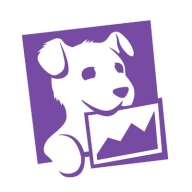

Datadog and Grafana Enterprise Stack compete in the monitoring and visualization space. Datadog seems to have the upper hand due to its comprehensive suite of monitoring tools and broader deployment options.
Features: Datadog offers monitoring tools that include logs, APM traces, RUM, and cloud infrastructure monitoring. It provides customizable dashboards and integrates with numerous platforms. Grafana Enterprise Stack stands out for its intuitive dashboards, visualization options, and support for various data sources.
Room for Improvement: Datadog could enhance its documentation, especially for auto instrumentation and tracing, and improve its UI for better usability. Cost control features also need strengthening. Grafana could benefit from integrating AI capabilities, offering a unified troubleshooting view, and improving application flow visualization.
Ease of Deployment and Customer Service: Datadog supports hybrid and public cloud deployments and is praised for its responsive customer support, though complex cases can face delays. Grafana Enterprise Stack is primarily on-premises and enjoys positive feedback for swift support but offers limited deployment options. Datadog's flexibility in deployment environments gives it a competitive advantage.
Pricing and ROI: Datadog is perceived as expensive but justifies the cost with its comprehensive tools leading to productivity gains and quick issue resolution. Pricing models like subscription plans help manage costs. Grafana Enterprise Stack is more budget-friendly with an open-source version and enterprise pricing based on data volume, ideal for small-scale deployments. While Grafana offers cost advantages, Datadog provides extensive features that can deliver substantial ROI, though at a higher initial cost.


Datadog is a comprehensive cloud monitoring platform designed to track performance, availability, and log aggregation for cloud resources like AWS, ECS, and Kubernetes. It offers robust tools for creating dashboards, observing user behavior, alerting, telemetry, security monitoring, and synthetic testing.
Datadog supports full observability across cloud providers and environments, enabling troubleshooting, error detection, and performance analysis to maintain system reliability. It offers detailed visualization of servers, integrates seamlessly with cloud providers like AWS, and provides powerful out-of-the-box dashboards and log analytics. Despite its strengths, users often note the need for better integration with other solutions and improved application-level insights. Common challenges include a complex pricing model, setup difficulties, and navigation issues. Users frequently mention the need for clearer documentation, faster loading times, enhanced error traceability, and better log management.
What are the key features of Datadog?
What benefits and ROI should users look for in reviews?
Datadog is implemented across different industries, from tech companies monitoring cloud applications to finance sectors ensuring transactional systems' performance. E-commerce platforms use Datadog to track and visualize user behavior and system health, while healthcare organizations utilize it for maintaining secure, compliant environments. Every implementation assists teams in customizing monitoring solutions specific to their industry's requirements.
Grafana Enterprise Stack is a powerful tool for real-time data monitoring and visualization. With its flexible and scalable features, it is widely used for creating dashboards, analyzing metrics, and gaining insights into infrastructure, databases, and applications.
Its valuable features include powerful visualization capabilities, extensive data source integrations, customizable dashboards, a user-friendly interface, and a robust alerting system. Users appreciate its flexibility, scalability, and ability to integrate with different data sources, making it suitable for a wide range of industries and use cases.
We monitor all IT Infrastructure Monitoring reviews to prevent fraudulent reviews and keep review quality high. We do not post reviews by company employees or direct competitors. We validate each review for authenticity via cross-reference with LinkedIn, and personal follow-up with the reviewer when necessary.